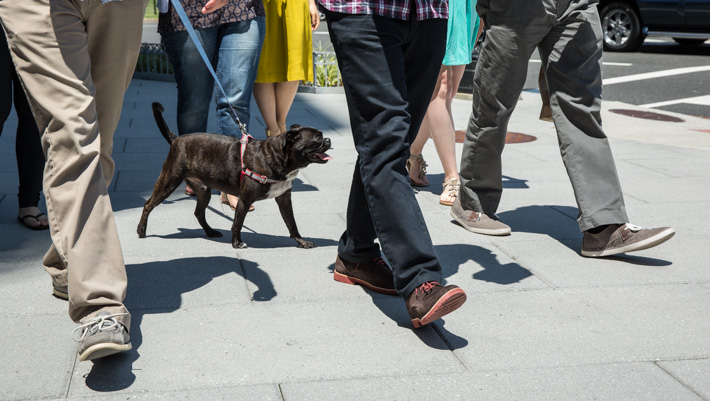The D.C. metropolitan region has been ranked the most walkable urban metro area in the U.S., according to a report released on Tuesday by the GW Center for Real Estate and Urban Analysis (CREUA) in conjunction with LOCUS, an advocacy coalition of Smart Growth America.
Research for the report, “Foot Traffic Ahead: Ranking Walkable Urbanism in America’s Largest Metros,” was led by GW School of Business Charles Bendit Distinguished Scholar Christopher B. Leinberger with support from Patrick Lynch, the CREUA research and development manager.
“There is a structural shift occurring in how real estate is developed in this country—from drivable suburban sprawl to walkable urbanism,” said Mr. Leinberger, who also serves as the chair of CREUA. “We wanted to document that trend and provide concrete, market-based evidence that walkable urban places can generate extraordinary economic value.”
The report is an update to a survey released by Mr. Leinberger and the Brookings Institution Metropolitan Policy Program in 2007. Since then, Mr. Leinberger has produced city-specific reports assessing walkability in metro D.C., Atlanta and Boston.
George Washington Today spoke with Mr. Leinberger about the newly released research and the relationship between urban walkability and growth.
Q: What does the report assess?
A: The report ranks each of the largest 30 metro areas in the country, focusing on the number of regional-significant walkable urban places, such as downtown D.C., Foggy Bottom, Reston Town Center, etc., and the percentage of walkable urban real estate development taking place in these metro areas. It also looks at recent trends in the commercial real estate market to evaluate where each metro area is headed—either toward more walkable urbanism, continued sprawl or somewhere in between.
Q: What are the key factors contributing to D.C.’s top ranking?
A: D.C. is in first place in the current ranking, which is the same spot that it earned in the 2007 survey. It has the highest percentage of office and retail space in walkable areas of any of the largest 30 metro areas. The major reason metro D.C. is number one on the list—ranking higher than New York—is that half of its walkable urbanism is in the suburbs, places such as Silver Spring, Md., and Arlington, Alexandria, and Reston Town Center in Virginia. The vast majority of walkable urbanism in New York is on Manhattan, where 8 percent of the population lives in only 0.3 percent of the landmass of the region. It is also interesting to note that nearly 54 percent of D.C.’s total office space is in a walkable place, but since 2010 walkable places with offices have accounted for 76 percent of newly absorbed office space. This means that walkable places in D.C. are gaining market share at the expense of drivable suburban areas—exactly the opposite of the trend that occurred during most of the late 20th century as we divested in our walkable urban places such as downtown.
Q: What is the difference between the most walkable and the least walkable metro areas in the country?
A: The most walkable metro areas have a highly educated workforce and high per-capita GDPs. With the exception of Seattle, all of the highly ranked metro areas have heavy rail networks. Although Seattle does not have a heavy rail system, it does have a few lines of a light rail system. That system is expanding across the metro area and has sparked a major “innovation district” in South Lake Union, which in the last 10 years has emerged as the cloud computer center of the planet. The lowest ranked metros generally have lower educational attainment, lower per-capita GDPs and much weaker or no rail transit systems. They also have fewer urbanized suburbs.
Q: How does walkable real estate relate to a city's economic and population growth?
A: Our report demonstrates that there is a strong correlation between the walkable urbanism of a metro area and a highly educated workforce and per-capita GDP. This is only a correlation, not a causal relationship, since much more research will be required to prove causality. The research also suggests that walkable urban places lead to better outcomes in terms of greenhouse gas emissions, public health and public sector fiscal health. According to our current research, the top-ranked metro areas have per-capita GDPs of $60,400. The lowest-ranked cities have a per-capita GDP of $43,900—a 38 percent difference.
Q: Can increased walkability have any negative effects on a metro area?
A: One real concern with these walkable urban places is the impact they can have on housing affordability. It is clear that people are willing to pay more to live in a walkable environment, which drives up the cost of housing. GW’s Center for Real Estate and Urban Analysis is cohosting a conference on Sept. 16 with the Urban Land Institute to explore the affordable housing challenge. We will announce the strategy we are developing with our partners to address the issue.


